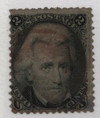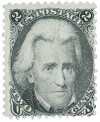
# 73 - 1863 2c Jackson, black
U.S. #73
1861 Andrew Jackson
- First time Andrew Jackson appeared on a U.S. stamp
- Ranked #19 in 100 Greatest American Stamps
- Nicknames: “Black Jack” and “Big Head”
Stamp Category: Definitive
Series: 1861-66 Issue
Value: 2c
Earliest Documented Use: July 1, 1863
Printed by: National Bank Note Co.
Quantity printed: 256,566,000 (estimate)
Format: Printed in sheets of 200 stamps, divided into vertical panes of 100 each
Printing Method: Engraving
Perforations: 12
Color:Black
Why the stamp was issued: As of March 3, 1863, a new Act of Congress went into effect. Distance was no longer a factor in determining domestic postage, so the 1c carrier fee was no longer charged. A 2c stamp was needed for the increased postal rate of 2c per half-ounce for drop letters and circulars. The #73 Andrew Jackson stamp also paid the new four-ounce third-class rate for newspapers and periodicals. The stamp was sometimes used bisected (cut in half) as a make-up rate in combination with another stamp.
About the printing: The design was engraved on a die – a small, flat piece of steel. The design was copied to a transfer roll – a blank roll of steel. Several impressions or “reliefs” were made on the roll. The reliefs were transferred to the plate – a large, flat piece of steel from which the stamps were printed.
About the design: The image of Andrew Jackson is based on a portrait miniature painted by American artist John Wood Dodge. It is the final portrait of Jackson completed before his death in 1845, aged 78.
Special design details: While known for being poorly centered, #73 is a popular stamp with collectors. Well-centered examples are hard-to-find and command premium prices.
The 2c stamp was ranked #19 in Janet Klug and Don Sundman’s book 100 Greatest American Stamps.
The stamp got its nicknames for obvious reasons. The stamp is black and its subject is Jackson, thus the name “Black Jack”. The stamp also stands out with its portrait taking up a large portion of the stamp. The size of the portrait in relation to the rest of the stamp lead collectors to give the stamp its other moniker: “Big Head”.
According to 100 Greatest American Stamps, “Placing his (Jackson’s) jumbo image on a United States stamp was meant to send a strong pro-Union message to the Confederate States of America” by a man who was idolized in the South. In turn, the CSA issued its own 2c stamp using the very same image, #CSA8.
About the 1861-66 Series: The series consists of US #73-78. The 5c Jefferson and 24c Washington stamps had the same face values and similar colors as those demonetized at the beginning of the Civil War. New to the line-up were the 2c Jackson, needed for the increased postal rate, and the 15c Lincoln stamp. The frame designs vary greatly from the Series of 1857-61. The denominations were not only written out, they were also shown in numerals displayed in the upper corners of the stamps. This helped distinguish them from the demonetized series, which could no longer be used. #77, the 15c Lincoln stamp, was the first presidential “mourning” stamp. Issued one year after his assassination, it was also the first 15c U.S. stamp, paying the single rate to France.
History the stamp represents: Due to the outbreak of the Civil War, all US stamps were demonetized and declared invalid for postage. This prevented the Confederate States of America (CSA) from selling them and using the money to support the Southern war effort.
The new stamps were sent to post offices along with a notice that required an exchange period of six days be announced in local newspapers. During the exchange period, old stamps could be exchanged for new ones. After the six-day exchange period, the old stamps were no longer accepted as postage.
U.S. #73
1861 Andrew Jackson
- First time Andrew Jackson appeared on a U.S. stamp
- Ranked #19 in 100 Greatest American Stamps
- Nicknames: “Black Jack” and “Big Head”
Stamp Category: Definitive
Series: 1861-66 Issue
Value: 2c
Earliest Documented Use: July 1, 1863
Printed by: National Bank Note Co.
Quantity printed: 256,566,000 (estimate)
Format: Printed in sheets of 200 stamps, divided into vertical panes of 100 each
Printing Method: Engraving
Perforations: 12
Color:Black
Why the stamp was issued: As of March 3, 1863, a new Act of Congress went into effect. Distance was no longer a factor in determining domestic postage, so the 1c carrier fee was no longer charged. A 2c stamp was needed for the increased postal rate of 2c per half-ounce for drop letters and circulars. The #73 Andrew Jackson stamp also paid the new four-ounce third-class rate for newspapers and periodicals. The stamp was sometimes used bisected (cut in half) as a make-up rate in combination with another stamp.
About the printing: The design was engraved on a die – a small, flat piece of steel. The design was copied to a transfer roll – a blank roll of steel. Several impressions or “reliefs” were made on the roll. The reliefs were transferred to the plate – a large, flat piece of steel from which the stamps were printed.
About the design: The image of Andrew Jackson is based on a portrait miniature painted by American artist John Wood Dodge. It is the final portrait of Jackson completed before his death in 1845, aged 78.
Special design details: While known for being poorly centered, #73 is a popular stamp with collectors. Well-centered examples are hard-to-find and command premium prices.
The 2c stamp was ranked #19 in Janet Klug and Don Sundman’s book 100 Greatest American Stamps.
The stamp got its nicknames for obvious reasons. The stamp is black and its subject is Jackson, thus the name “Black Jack”. The stamp also stands out with its portrait taking up a large portion of the stamp. The size of the portrait in relation to the rest of the stamp lead collectors to give the stamp its other moniker: “Big Head”.
According to 100 Greatest American Stamps, “Placing his (Jackson’s) jumbo image on a United States stamp was meant to send a strong pro-Union message to the Confederate States of America” by a man who was idolized in the South. In turn, the CSA issued its own 2c stamp using the very same image, #CSA8.
About the 1861-66 Series: The series consists of US #73-78. The 5c Jefferson and 24c Washington stamps had the same face values and similar colors as those demonetized at the beginning of the Civil War. New to the line-up were the 2c Jackson, needed for the increased postal rate, and the 15c Lincoln stamp. The frame designs vary greatly from the Series of 1857-61. The denominations were not only written out, they were also shown in numerals displayed in the upper corners of the stamps. This helped distinguish them from the demonetized series, which could no longer be used. #77, the 15c Lincoln stamp, was the first presidential “mourning” stamp. Issued one year after his assassination, it was also the first 15c U.S. stamp, paying the single rate to France.
History the stamp represents: Due to the outbreak of the Civil War, all US stamps were demonetized and declared invalid for postage. This prevented the Confederate States of America (CSA) from selling them and using the money to support the Southern war effort.
The new stamps were sent to post offices along with a notice that required an exchange period of six days be announced in local newspapers. During the exchange period, old stamps could be exchanged for new ones. After the six-day exchange period, the old stamps were no longer accepted as postage.












